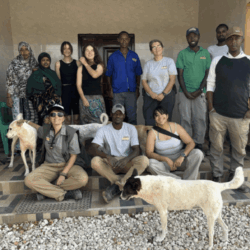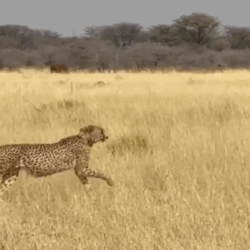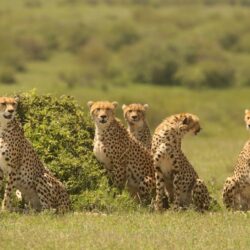How is the Cheetah Skeleton Different from Other Cats?
-

- by Amy Cocksedge August 9, 2020

Looking at cheetahs, most people would classify them as ‘cats’. However, if you were to put a cheetah and your house cat side-by-side, they would likely look quite different. The cheetah would be taller, their legs and tail would be longer, and they would likely be slenderer overall. That is because cheetahs are designed from the inside out to be extremely fast. What is the foundation of this design? Their skeleton.
There is strong relationship between the skeleton of an animal and how that animal moves. This relationship is so important that analyzing limb bone measurements is one of the ways we understand how ancient species moved. For the Felidae family (the cat family), research has shown that limb shape is related to hunting strategies, and limb structure can tell us important information about their prey size. As ‘sprinters’, cheetahs need a skeleton that will allow them to not only run at very high speeds, but reach those speeds quickly and hunt while doing so.
As with all felids, cheetahs have narrow hips and shoulders. However, they also have longer radius and humerus bones (front leg bones) compared to other felids. Additionally, cheetahs’ bones overall are more slender than other mammals. Slender, light bones allow for an animal to maintain energy efficiency during movement. As such, it is thought that their slender bones allow cheetahs to reach and maintain their high speeds.
Another unique skeletal attribute is that cheetahs’ front limbs are different from their hind limbs. This means they can perform different actions with different limbs. One major advantage is the ability to manipulate objects with their front paws. For cheetahs, this means they are able to grab and hold onto prey when hunting, maximizing success. As cheetahs are not as strong as other felids, they rely on their ability to use their dew claw to grab onto the rump of a prey species and throw it off balance while running. Their skeleton allows this because they have increased “supination” – the ability to move their paws up and down.
One of the most important requirements for an animal to reach top speeds is their ability to swing their limbs very quickly to increase how often they can push off the ground. This is called ‘stride frequency’. It is believed that cheetahs long limbs are the reason they have a high stride frequency and therefore high speed. Maximum speed also requires longer amounts of time an animals’ feet touch the ground (called “stance time”), as this allows them better control of their movements. While most species have less contact with the ground at higher speeds, cheetahs do not. This is possible because cheetahs have pivoting hip bones, shoulder blades that are not attached, and a flexible spine. It is also believed that their long limbs allow their centre of mass to move more than other animals whilst their feet are on the ground, allowing for longer contact with the ground. In turn, this increases their speed.
The elements of the cheetah’s skeleton show that they are truly unique, from the inside out.
References:
Day, L. M., & Jayne, B. C. (2007). Interspecific scaling of the morphology and posture of the limbs during the locomotion of cats (Felidae). Journal of Experimental Biology, 210(4), 642-654.
Hudson, P. E., Corr, S. A., Payne‐Davis, R. C., Clancy, S. N., Lane, E., & Wilson, A. M. (2011). Functional anatomy of the cheetah (Acinonyx jubatus) forelimb. Journal of Anatomy, 218(4), 375-385.
Keller, T. S., Weisberger, A. M., Ray, J. L., Hasan, S. S., Shiavi, R. G., & Spengler, D. M (1996). Relationship between vertical ground reaction force and speed during walking, slow jogging, and running. Clinical biomechanics, 11(5), 253-259.
Martín‐Serra, A., Figueirido, B., Pérez‐Claros, J. A., & Palmqvist, P. (2015). Patterns of morphological integration in the appendicular skeleton of mammalian carnivores. Evolution, 69(2), 321-340.
Randau, M., & Goswami, A. (2018). Shape covariation (or the lack thereof) between vertebrae and other skeletal traits in felids: the whole is not always greater than the sum of parts. Evolutionary biology, 45(2), 196-210.
Randau, M., Goswami, A., Hutchinson, J. R., Cuff, A. R., & Pierce, S. E. (2016). Cryptic complexity in felid vertebral evolution: shape differentiation and allometry of the axial skeleton. Zoological Journal of the Linnean Society, 178(1), 183-202.
Weyand, P. G., Sternlight, D. B., Bellizzi, M. J., & Wright, S. (2000). Faster top running speeds are achieved with greater ground forces not more rapid leg movements. Journal of applied physiology, 89(5), 1991-1999.
Related Reading
-
November 23, 2025
Canadian Veterinarian Reunites With Rescued Cheetahs – Somaliland



